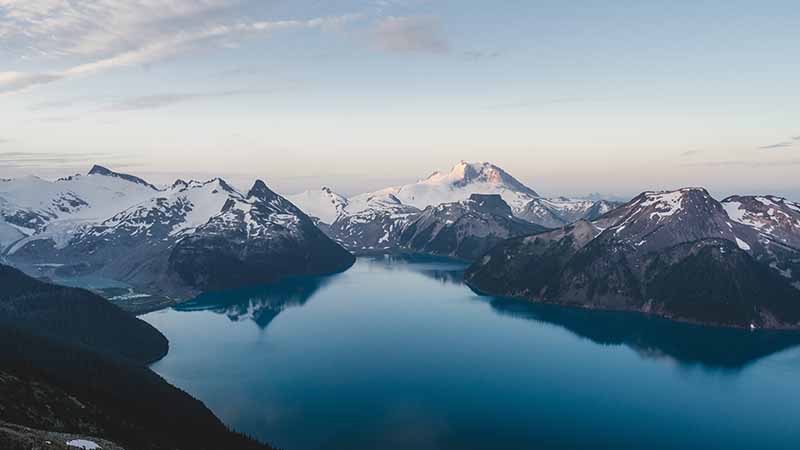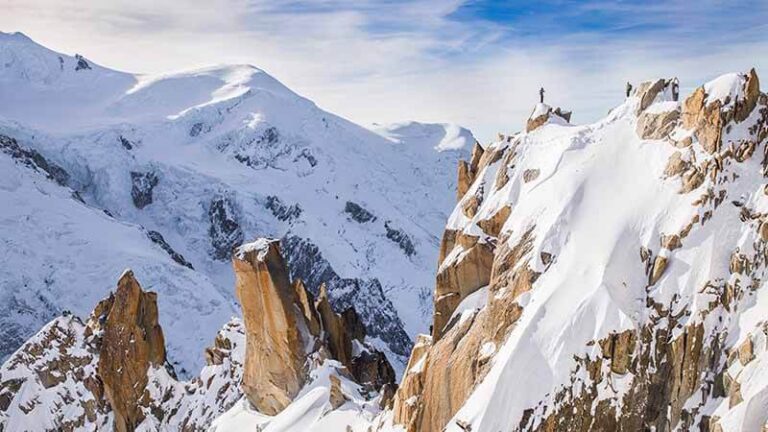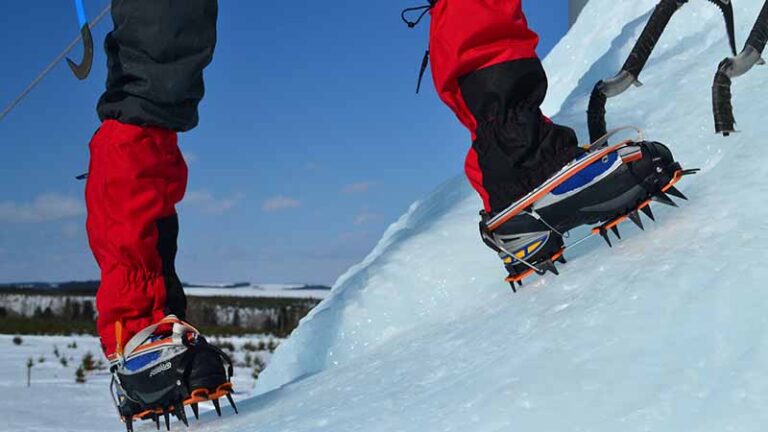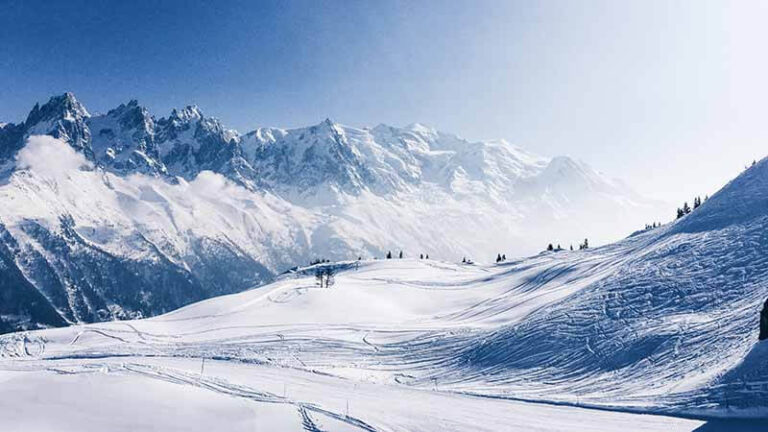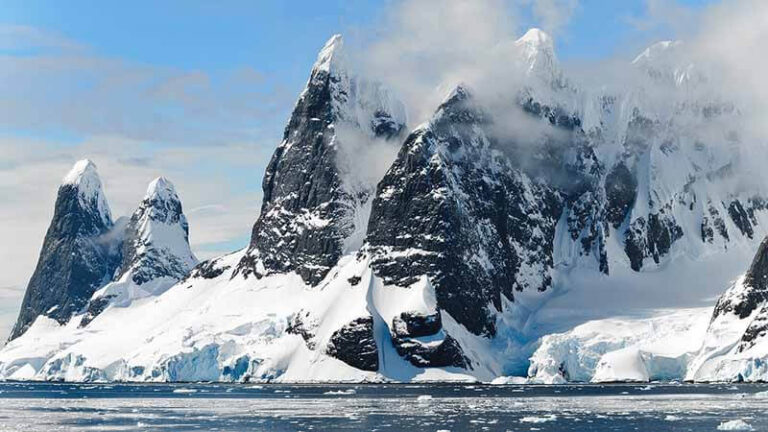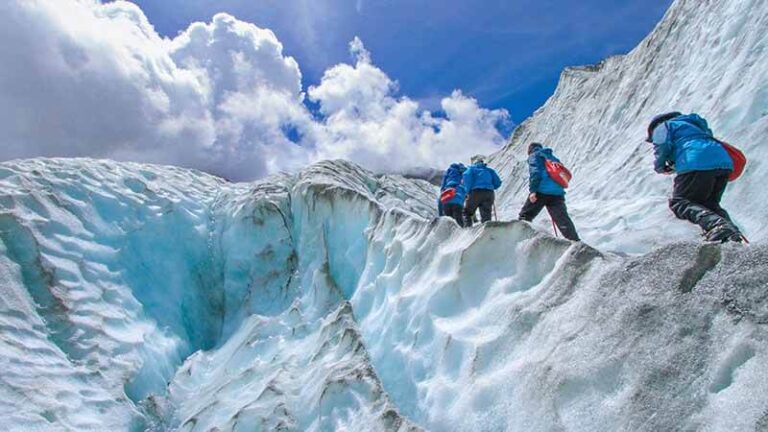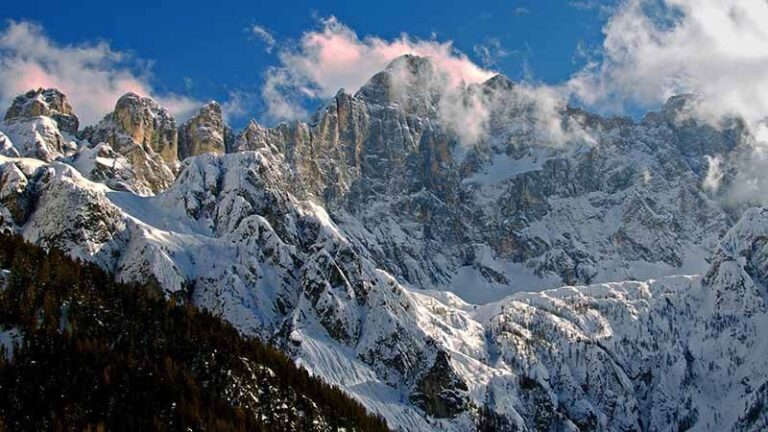Advanced Techniques for Ice Climbing with Ascenders
Ice climbing using ascenders is a type of mountaineering that includes scaling frozen waterfalls, glaciers, and other icy terrain with the help of mechanical equipment known as ascenders.
Ascenders are vital climbing equipment that grasp the rope and allow for upward progress while preventing backsliding. They offer stability and support in difficult ice climbing situations, allowing climbers to tackle steep, vertical, and occasionally overhanging ice features.
Ascenders are commonly used in ice climbing in conjunction with ropes and ice screws to build a safe and efficient system. Climbers attach the ascenders to their harnesses and use them to ascend the rope in a methodical and purposeful manner.
Climbers can use this technique to access distant and difficult ice routes that would otherwise be inaccessible without the use of ascenders.
Importance of Advanced Techniques for Experienced Climbers
Advanced ice climbing techniques with ascenders are essential for experienced climbers wishing to test their boundaries and broaden their skill set.
While fundamental ascender abilities are required for safe and pleasant ice climbing, advanced techniques propel climbers to the next level of expertise. Here’s why these strategies are so important:
- Greater Versatility: Advanced techniques provide climbers with the ability to tackle a broader range of ice climbing circumstances. This entails handling overhanging ice, intricate traverses, and obstacles such as ice bulges and chockstones. Versatility is essential for overcoming difficult climbs.
- Improved Efficiency: Advanced ascender techniques optimize mobility while decreasing energy expenditure. Climbers can ascend more quickly and fluidly, making long and difficult ice climbs more manageable.
- Risk Management: As climbs become more technical, so does the risk component. Advanced climbing tactics not only boost performance but also emphasize safety and risk management strategies. Climbers with experience can make smart decisions to reduce dangers.
- Personal Development: Ice climbing with ascenders is a mental as well as a physical challenge. Advanced tactics increase confidence and mental fortitude, allowing climbers to face routes that may have been intimidating in the past.
- Community and Mentorship: Mastering advanced ascender skills frequently necessitates engagement with a community of experienced climbers. It promotes friendship and mentorship by allowing climbers to share their knowledge and experience.
What are Ice Climbing Ascenders?
Ice climbing ascenders are specialized mechanical devices that help climbers as they ascend ropes on icy terrain. They are essential for ice climbing because they provide stability, support, and security when scaling frozen waterfalls, glaciers, or high ice walls. Ascenders are small, lightweight tools that are easy to transport and use, making them essential for ice climbers.
The basic purpose of ice climbing ascenders is to securely grip the rope while allowing for upward movement and preventing backsliding.
A handle or grip, a camming mechanism, and a toothed or serrated surface that bites into the rope are all common components.
When a climber pulls up on the ascender, it latches onto the rope and holds their position. When they let go of the rope, the cam opens, enabling the rope to pass through.
Ice climbing ascenders exist in a variety of shapes and configurations, but their primary purpose remains the same: to provide the climber with a reliable means of safely and efficiently ascending ropes on icy terrain.
Types of Ascenders Used in Ice Climbing
- Handheld Ascenders: The most frequent type of ice climbing equipment is the handheld ascender. They have a handle that the climber clutches and squeezes in order to activate the camming mechanism.
- These ascenders are adaptable and can be modified while still attached to the rope. To aid efficient movement, they are frequently used in pairs, one for each hand.
- Chest Ascenders: Chest ascenders are attachable to the climber’s chest harness. They are combined with portable ascenders to form a two-point system. This configuration enables climbers to efficiently ascend vertical ice by pushing against the ice with their legs while pulling up with their hands.
- Foot Ascenders: Foot ascenders are attachable to the climber’s boot or crampon. They give extra support and stability when climbing ropes. Climbers can use them to “walk” up the rope, dividing their work between their hands and feet, which is especially effective on long and steep ice climbs.
- Petzl Tibloc and Micro Traxion: These small gadgets, while not standard ascenders are often employed in ice climbing for emergency self-rescue and progression. They are compact, lightweight, and portable. In an emergency, the Petzl Tibloc can be used to ascend ropes.
- Specialized Ice Climbing Ascenders: Some manufacturers produce ice climbing ascenders with features such as insulated grips or anti-ice mechanisms to prevent freezing in cold circumstances. These ascenders are designed specifically for the unique problems of ice climbing.
Basic Principles of Using Ascenders in Ice Climbing
- Appropriate Attachment: Before utilizing ascenders, climbers must check that they are properly linked to their harness, chest, or boots, depending on the type. Attachment points should be strong enough to support the climber’s weight.
- Positioning: To enhance efficiency, climbers should position ascenders accurately on the rope. Handheld ascenders are often placed around the waist, whilst chest and foot ascenders should be placed to allow for fluid movement and weight distribution.
- Tension Control: In order to activate the camming mechanism, climbers must provide tension to the rope by pulling up on the ascender. When tension is released, the ascender can slide freely on the rope. Smooth and controlled ascents require proper tension management.
- Safety Backups: Climbers should always have safety backups in place. Knots knotted below the ascenders, backup devices, or prusik cords are examples of this. In the event of a system failure, safety measures are crucial to reducing the possibility of unintentional descents.
- Practice and Training: Ascender method mastery necessitates practice and training. To guarantee safe and efficient use, climbers should become familiar with their ascenders’ operation, experiment with different setups, and seek help from experienced climbers or instructors.
Essential Preparations
Gear and Equipment Checklist
Preparing for advanced ice climbing ascender techniques necessitates close attention to gear and equipment. Climbers should use a complete gear checklist to ensure they have everything they need for a successful and safe ascent.
- Ascenders: Begin with high-quality ascenders that are appropriate for the type of ice climbing you intend to accomplish. Check that they are well-maintained, lubricated, and in good operating order.
- Ropes: Use dynamic climbing ropes designed for ice climbing. To avoid freezing, make sure they are free of breakage, kinks, or knots and have been properly kept.
- Safety gear: Ice screws, ice hooks, and other safety gear are essential for route anchoring and protection. Carry a variety of sizes to account for varying ice conditions.
- Harness: Check that your climbing harness is comfortable and secure. Check the integrity of all harness attachments, buckles, and gear loops.
- Crampons and footwear: Invest in ice climbing crampons that are appropriate for your footwear. Examine for sharp edges and secure attachments. Make sure your boots are properly sized and insulated for warmth and comfort.
- Helmet: Keep your head safe by using an ice climbing helmet. It should defend against both impact and puncture.
- Layer your clothing to manage your body temperature. In cold, wet weather, insulated, moisture-wicking clothing is vital for staying warm and dry.
- Gloves and Hand Protection: Insulated gloves with dexterity are required. Carry additional gloves in case yours becomes wet or freezing.
- headlight: A dependable headlight with spare batteries is essential for navigating in low-light settings and during emergencies.
- First Aid Kit: Bring a small first aid kit specifically designed for ice climbing accidents, including wound care, cold-related ailments, and basic survival supplies.
- Navigation Tools: Carry a map, compass, and GPS device with you to help you navigate, especially in unfamiliar territory or in bad weather.
- Communication: For emergency scenarios, include a fully charged communication device such as a satellite phone or an emergency locating beacon.
Physical and Mental Preparations for Advanced Ascender Techniques
It is critical to prepare physically and psychologically for advanced ascender skills in order to have a safe and effective ice climbing experience.
- Physical Fitness: Ice climbing necessitates strength, endurance, and flexibility. Exercise on a regular basis, including cardiovascular workouts, weight training, and flexibility exercises. Exercises that target the muscles required in ice climbing, such as the core, forearms, and legs, are essential.
- Mental Preparedness: Ice climbing can be mentally taxing. Prepare by envisioning the ascent, anticipating probable difficulties, and cultivating a positive, resilient mindset. Mental readiness allows you to focus, make better judgments, and deal with fear.
- Skill Development: Before progressing to more sophisticated movements, devote time to learning basic ascender methods. To hone your skills, take ice climbing classes or seek advice from expert climbers.
- Route Research: Conduct preliminary research on the ice climbing route of choice. Learn about its characteristics, challenges, and potential perils. Having a clear mental picture of the journey will help you feel more confident.
- Practice and Simulation: Before attempting an advanced climb, practice using ascenders and other equipment in a controlled setting. Simulate difficult situations and learn self-rescue tactics.
Safety Considerations
Safety should always come first when ice climbing, especially when using sophisticated ascender techniques.
- Risk evaluation: Perform an in-depth risk evaluation of the climb. Consider weather conditions, avalanche risk, route conditions, and your own preparedness. If weather conditions are bad, be prepared to cancel or postpone the ascent.
- Climbing Companions: Never attempt to climb alone. Collaboration with experienced climbers or guides who are familiar with the terrain and skills is recommended. Communication and teamwork are essential for safety.
- Weather Monitoring: Keep up to date on weather forecasts and developments. Unpredictable weather can be quite dangerous when ice climbs.
- Avalanche Awareness: Be mindful of avalanche threats in hilly areas and carry avalanche safety equipment such as beacons, shovels, and probes.
- Emergency Preparedness: Make an emergency plan. Share your itinerary with someone who can notify authorities if you do not return on time. Learn self-rescue skills and keep the appropriate supplies on hand.
- Making Conservative Decisions: Be prepared to backtrack if conditions worsen or unforeseen challenges arise. Never let pride take precedence over safety.
Ascending Overhanging Ice
Overview of Overhanging Ice Climbs
Overhanging ice climbs are among the most difficult and exciting aspects of ice climbing. These climbs have ice structures that extend away from the vertical plane, resulting in enormous, intimidating bulges or roofs.
Because of the peculiar angle of ascent and the potential for additional physical strain, ascending overhanging ice necessitates a distinct set of abilities and approaches.
Overhanging ice climbs are most common in places with constant freezing temperatures, where ice can collect and form these stunning landforms. Climbers are drawn to overhanging climbs for the sheer thrill and sense of accomplishment that comes with overcoming such difficult terrain. These climbs, however, come with increased technical difficulty and physical demands.
Body Positioning and Weight Distribution
Proper body stance and weight distribution are critical for a successful ascent of overhanging ice. The following are fundamental characteristics of the technique:
- Body Lean: When climbing an overhanging stretch of ice, climbers should lean back into the ice to offset their weight. This position relieves tension on their arms and allows them to make better use of their legs.
- Leg Muscle Engagement: In overhanging climbs, engaging the leg muscles becomes crucial. Climbers should kick their crampons into the ice to provide stability and support. Alter between high and low kicks to establish a rhythm that aids in upward advancement.
- Heel Hooks and Toe Picks: Use heel hooks and toe picks to secure your grip on the ice. Hooking the heel or toe of your crampons onto projecting features or fissures in the ice is what these moves entail. This contributes to the stability and lessens reliance on arm strength.
- Dynamic Movement: Climbing overhanging ice frequently requires dynamic, fluid motions. To conserve energy, climbers should try for seamless transitions between placements and a regulated, rhythmic flow.
Proper Placement and Adjustment of Ascenders
The positioning and adjustment of ascenders are critical for safe and efficient progress on overhanging ice climbs. Here’s how to utilize ascenders properly:
- Initial Positioning: Begin by securing one of your ascenders to the rope above the overhang. To prevent backsliding, make sure it has a firm grasp on the rope.
- Secondary Ascender: Attach a secondary ascender to the rope just beneath the overhang. This prevents excessive slack in the rope and adds stability.
- Tandem Movement: Ascend with your legs and arms at the same time. Move the ascenders up the rope as you kick into the ice and advance your body. It is critical to maintain proper coordination between your bodily actions and ascender adjustments.
- Constant Tension: With your ascenders, keep a continuous tension on the rope. Excessive slack might cause issues when ascending overhangs.
- Micro Adjustments: As needed, make minor, accurate adjustments to the ascenders. Micro-adjustments ensure that the ascenders hold securely without being too tight, which can be tiresome.
Safety Measures for Overhangs
Because of the greater risk of falling and the possibility of ice fractures, overhanging ice climbs require special precautions. Here are several key safety precautions:
- Protection Points: As you ascend, insert ice screws or other protection measures into the ice. These serve as anchors and give points of safety in the event of a fall.
- Wear a climbing helmet to protect yourself from falling ice and debris that can become dislodged while ascending overhangs.
- Communication: Keep in constant contact with your climbing buddy. Because overhanging areas might reduce visibility, verbal communication becomes critical for coordination.
- Fall Prevention: Plan for falls and practice self-arrest strategies. Overhanging ice climbs can require rigorous movements and a higher danger of losing equilibrium.
- Team Dynamics: Climbing in couples or groups is recommended for safety. A belayer can act as a safety backup and aid in the event of a fall.
- Avalanche Awareness: Avalanche-prone areas may contain overhanging ice climbs. Avalanche conditions should be monitored and necessary precautions taken, such as carrying avalanche safety equipment.
Traversing Techniques
Types of Ice Traverses
Ice traverses, which involve horizontal or diagonal motions across icy surfaces, are an important part of ice climbing. These traverses vary in difficulty and necessitate specific strategies. Here are some examples of popular ice traverses:
- Horizontal Traverse: Climbers go laterally along a horizontal plane of ice in this traverse. While it may appear to be less difficult than other forms, keeping balance and grip on icy surfaces can be difficult, especially in harsh weather.
- Diagonal Traverse: A diagonal traverse entails rising or descending over the ice at an angle. Climbers must carefully balance their weight while climbing the hill, securing footholds and handholds with ice tools and crampons.
- Mixed Traverse: A mixed traverse combines ice and rock characteristics. Climbers frequently switch between ice and rock terrain, necessitating versatility in both gear and technique. Mixed traverses necessitate adaptability and the ability to alter the climbing method quickly.
- Overhanging Traverse: As the name implies, overhanging traverses entail navigating ice features that extend away from the vertical plane. In these physically demanding traverses, climbers must struggle with difficult body placement, stability, and tiredness.
- Snow Bridge Traverse: Snow bridges can form over crevasses or gaps on alpine ice climbs. To guarantee that these snow bridges can securely support the climber’s weight, they must be probed and tested.
Balance and Stability on Traverses
On ice treks, maintaining balance and stability is critical for safe and efficient progress. The following are some major techniques:
- Maintain a balanced and erect posture while evenly dispersing your weight between your crampons and ice tools. Excessive tilting in either direction might result in slips and falls.
- Wide Stance: Maintain a firm basis by keeping your feet shoulder-width apart. This improves weight distribution and reduces the likelihood of sliding or slipping on slippery surfaces.
- Consistent Pressure: Apply consistent pressure to your feet as well as your ice tools. Even, controlled force aids in the maintenance of grip and stability. Avoid over-gripping your tools, as this might cause tiredness.
- Kick-In Steps: Use your crampons to produce firm footholds when traveling at an angle. To form steps that can hold your weight, make precise kicks into the ice. Keep a steady beat when kicking in steps to improve stability.
- Minimal Swing: Keep your ice tool strokes thoughtful and controlled. Swinging too much can knock you off balance. Instead, engage the ice with small, controlled swings.
Effective Use of Ascenders While Traversing
Climbers may need to employ ascenders wisely while traversing to aid their progress. Here are some pointers for using an ascender effectively during traverses:
- Movement Direction: Ascenders should be placed on the rope in the direction of your traverse. Maintain an efficient angle by adjusting their positioning as you go.
- Simultaneous Movement: Ascend while moving your feet with your arms and hands. This synchronized motion ensures that the ascenders keep the rope taut, preventing any unexpected slack.
- Slack Control: Keep a close eye on rope slack. Too much slack might make it difficult to ascend and maintain balance. Maintain a taut rope between the ascenders and your point of connection.
- Safety Backup: When employing ascenders, make sure you have a solid safety backup system. This could include knots tied beneath the ascenders or a second rope for redundancy.
Managing Rope and Protection Points During a Traverse
Rope management and safety points are key components of ice traverses:
- Protection Points: To secure your traverse, place ice screws or other protection measures at regular intervals. In the event of a fall, protection points act as anchors and can prevent a disastrous swing.
- Rope Alignment: Keep the rope aligned with your travel direction. Allowing it to traverse your body can result in entanglement or interference with your tools.
- effective Clipping: Use effective clipping techniques while employing quickdraws or slings for protection. Clip the rope into the safety points without wasting energy or time.
- Communication: Keep in constant contact with your climbing partner or team. Coordination is especially important during traverses when sight is limited and climbers may be on different courses.
Negotiating Obstacles
Identifying Common Obstacles in Ice Climbing
Ice climbers frequently encounter a variety of challenges during their ascent, which necessitate the use of specialized tactics and equipment to safely negotiate. Common ice climbing challenges include:
- Ice Bulges: These are large, projecting chunks of ice that can produce difficult vertical or overhanging terrain. Bulges may necessitate unconventional route-finding and climbing strategies.
- Chockstones are massive, embedded rocks or ice blocks within an icefall. Climbers must maneuver around, over, or under them, which can be physically and technically hard.
- Crevasses: Crevasses are a key impediment in glacier-based ice climbs. To cross these deep, often hidden, ice breaches, specific safety equipment such as snow bridges or rope systems may be required.
- Serpentine Ice: Serpentine patterns with twists, curves, and narrow parts can be found in some icefalls. Climbers must modify their skills and navigation to deal with these difficult obstacles.
- Melt Holes: Melting ice pockets can generate holes or cavities within the icefall. These concealed holes represent instability hazards and necessitate thorough exploration and examination.
Ascending Past Obstacles
Obstacles in ice climbing require precise tactics to overcome the difficulties caused by these features:
- Assess the obstruction: Before attempting to ascend, carefully assess the size, form, and orientation of the obstruction. Understanding its qualities will aid you in planning your strategy.
- Alternative Routes: Search for alternate trails or weak points in the obstruction where you can fasten your equipment and crampons. Ice fractures, cracks, or thinner parts may be involved.
- applying Leverage: When dealing with ice bulges or chockstones, consider applying leverage by latching your ice tools or crampons onto the upper edge of the obstruction and dragging yourself up. This method necessitates a strong core and arm muscles.
- Dry Tooling: Dry tooling is a technique in which ice tools are used to climb rock or ice without relying on the structural stability of the ice. It is frequently used when dealing with diverse terrain or less stable ice conditions.
- Trenching: If you can’t climb over an impediment, dig a trench or tunnel through it. This entails mining the ice with ice tools, which finally allows you to pass.
- Backstepping and Flagging: To maintain balance and stability when traveling around an obstacle’s edge, employ backstepping and flagging procedures. This entails deliberately arranging your feet and torso to distribute weight appropriately.
Use of Specialized Gear and Advanced Ascender Configurations
Ice climbing challenges can necessitate the use of specialized equipment and complex ascender configurations:
- Ice Hooks and V-Threads: Ice hooks are useful for gaining a grip on chockstones or ice bulges. Drilling holes in the ice to establish anchors for rappelling or fastening ropes is what V-threads are all about.
- Ice Pitons and Peckers: Pitons and peckers are metal objects driven into ice or rock to offer temporary anchor points or to assist in ascending difficult portions.
- Advanced Ascender setups: Advanced ascender setups may be required depending on the obstacle. Some climbers, for example, employ tandem ascenders or customizable systems to negotiate difficult terrain.
- Climbing Aid Accessories: When dealing with barriers, specific gear such as nut tools, pick weights, and specialized ice protection devices can be employed for stability and security.
Safety Precautions When Dealing with Obstacles
When handling ice climbing difficulties, safety is of the utmost importance. Here are several important safety precautions:
- Assessment and Planning: Carefully assess the stability of the obstacle as well as the safety of your proposed route. Prepare escape routes and a backup strategy in case your initial approach becomes risky.
- Communication: Keep in constant contact with your climbing partner or team. When dealing with impediments, make sure they are aware of your location and progress.
- Protection Points: Use ice screws or other safety devices to provide reliable anchors in the event of a fall or to secure ropes when traversing obstacles.
- Self-Rescue procedures: Practice self-rescue procedures like as mounting a rope or escaping a crevasse, as these might be useful when dealing with obstacles.
- Avalanche Awareness: Be aware of avalanche threats in alpine areas, especially when crossing difficult terrain. Carry the essential avalanche safety equipment and remain up to date on current circumstances.
- Retreat Option: Keep a retreat option in mind at all times. If the roadblock proves insurmountable or the conditions worsen, be prepared to retrace your steps.
Ice climbing obstacles demand a combination of talent, adaptation, and an acute sense of safety. While navigating difficult ice aspects, climbers must be prepared to assess, adapt, and make informed decisions.
Advanced Anchoring Strategies
Importance of Secure Anchors in Advanced Ascender Techniques
Secure anchors are critical in advanced ice climbing ascender techniques. These tactics frequently include crossing difficult terrain, such as overhangs, traverses, and obstructions. Climbers rely on anchors in such situations to provide stability, prevent falls, and allow for controlled movement.
Because ice climbing is dynamic and unpredictable, anchors must be not only safe but also flexible to the individual demands given by the climb. Without dependable anchors, the climber’s safety is jeopardized, and the chance of accidents and injuries skyrockets.
As a result, the importance of secure anchors cannot be emphasized, as they serve as the foundation for safe and effective advanced ascender techniques.
Anchor Selection and Placement for Overhangs, Traverses, and Obstacles
Anchor placement and selection in advanced ascender techniques must be adapted to the type of terrain being climbed. Anchors for overhangs, traverses, and obstructions are commonly chosen and positioned as follows:
- Overhangs: Climbers may need to set ice screws or specialized rock protection in horizontal fissures or pockets within the ice when dealing with overhanging portions. These anchors should be properly placed to offer both upward and lateral stability. For increased security, a multi-point anchor system is frequently required.
- Traverses: Climbers can employ ice screws or other protection devices for traverses, inserting them into horizontal cracks or solid ice features that run along the traverse route. The objective is to place the protection points at regular intervals to reduce potential swing in the event of a fall. Multiple anchors may be necessary depending on the length and complexity of the traverse.
- Obstacles: Climbers may need to employ rock protection gear, pitons, or ice hooks to construct solid anchors while negotiating obstacles such as chockstones. These anchors should be chosen based on the composition and stability of the obstacle. Climbers can also use slings or quickdraws to temporarily hold themselves to these anchors while navigating the obstacle.
Climbers should always emphasize the quality of the ice or rock into which the anchors are set. Anchors that are strong and well-attached are vital for safe passage.
Furthermore, redundancy in anchor placement is a great practice since it provides a backup in the event that one anchor fails or is compromised.
Multi-Point Anchoring for Added Safety
Multi-point anchoring is an important safety precaution used in advanced ascender techniques. It entails using many anchors to spread the load and improve stability. The following are the most important characteristics of multi-point anchoring:
- Equalization: Climbers should strive to equalize the load across several anchors while installing them. This reduces the danger of anchor failure by preventing one anchor from receiving the brunt of the force.
- Extension Prevention: To prevent extensions (rope stretch), connect anchors with dynamic materials such as slings or cordage. In the case of a fall, dynamic elements absorb stress and limit the possibility of abrupt loading on the anchors.
- Backups: Create backup anchor systems whenever possible. This increases the anchoring system’s redundancy, providing a safety net in the event that one set of anchors fails. Backup systems should be secure and isolated from the primary anchors.
- Anchor Direction: When installing anchors, consider the direction of the pull. Ascertain that they are orientated to withstand the expected forces and to reduce the possibility of anchor movement or dislodgment.
When handling overhangs, traverses, or obstructions, multi-point anchoring is especially important because these scenarios can apply lateral and vertical stresses on the anchor system.
Climbers can considerably improve the safety and reliability of their ice climbing ascender skills by using advanced anchoring strategies and multi-point systems, enabling more controlled and confident movement in difficult terrain.
Building Confidence in Advanced Techniques
Progressive Training and Skill Development
Building confidence in advanced ice climbing techniques such as mounting overhanging ice, traversing, and negotiating obstacles necessitates a methodical approach to training and skill development. Here’s how climbers can gradually improve their skills and confidence:
- Ice Climbing Foundational Skills: Begin by mastering the fundamentals of ice climbing, such as basic ascender techniques, proper ice tool usage, and crampon techniques. These essential skills serve as the foundation for advanced techniques.
- Incremental Progression: Challenge yourself gradually by tackling climbs that contain components of the advanced techniques you want to learn. Begin with routes that have only minimal overhangs, gentle traverses, or impediments. Gradually progress to more difficult terrain as you develop confidence and proficiency.
- Structured Training: Include structured training in your routine. During training sessions, concentrate on certain aspects of advanced skills. Devote time, for example, to overhang-specific exercises or traverse practice to refine your skills.
- Mental Preparation: Building confidence requires more than just physical ability; mental preparation is also essential. Maintain a positive outlook and use mental skills to control fear and anxiety in high-stress circumstances as you prepare for difficult climbs.
- Consistency: Training and climbing experiences must be consistent. Engage in ice climbing on a regular basis to strengthen your skills and adapt to different circumstances and challenges.
- Safety First: While pushing your limits is important for progress, never put your safety first. Always emphasize safety measures, wear sufficient protection, and make informed mountain decisions.
- Seek criticism: Don’t be afraid to ask experienced climbers or instructors for criticism. Constructive criticism can assist you in identifying areas for improvement and improving your technique.
Importance of Mentorship and Guided Climbs
Mentorship and guided climbs are essential for developing confidence in advanced ice climbing skills. Here’s why they’re necessary:
- Experience-Based Learning: Mentors and guides bring years of experience and knowledge to the table. They’ve been in a variety of climbing situations, including ones requiring advanced tactics. Learning from their ideas and lessons will help you build your skills faster.
- Hands-On Instruction: Climbing with a mentor or guide allows for hands-on instruction. They can show techniques, provide rapid feedback, and provide specific instruction based on your skills and objectives.
- Risk Management: Experienced climbers can teach you essential lessons in risk management and safety, allowing you to make informed decisions in difficult situations. They are excellent at analyzing risks and implementing preventative actions.
- Support and friendship: Climbing with mentors and guides promotes a sense of camaraderie and support. It fosters a learning environment in which you may ask questions, exchange experiences, and be inspired by individuals who have experienced similar obstacles.
- Confidence Boost: Climbing with experienced people might help you gain confidence. Their presence and advice can assist you in overcoming self-doubt and worry, allowing you to concentrate on the climb itself.
- Access to New Terrain: Guides frequently have access to distant and less-frequently visited climbing sites, allowing you to practice advanced techniques in a variety of thrilling environments.
- Gradual Progression: Climbs can be tailored to your ability level, gradually increasing the complexity and intensity as you gain experience. This gradual approach ensures that you gain confidence at your own speed.
Safety Considerations and Risk Management
Risk Assessment for Advanced Ascender Techniques
Risk assessment is essential in ice climbing, especially when using sophisticated ascender techniques. Climbers must do extensive risk assessments before and throughout their climbs to mitigate potential hazards:
- Pre-Climb Evaluation: Before beginning an ice climb, consider weather conditions, avalanche risk, route conditions, and your personal fitness. Determine whether your skill level corresponds to the difficulty of the climb and whether your equipment is appropriate for the conditions.
- Terrain Assessment: Continuously analyze the terrain for potential threats while climbing. Overhangs, traverses, and barriers pose distinct risks that must be carefully assessed. Recognize hazards to your safety, like unstable ice, hanging seracs, or crevasses.
- Avalanche Awareness: Maintain a heightened awareness of avalanche threats in alpine situations. Consult avalanche predictions and bring the required safety equipment, such as avalanche transceivers, shovels, and probes. During periods of increasing avalanche hazard, avoid high-risk places.
- Route Evaluation: Examine the history, reputation, and most recent conditions of the route. Gather information from climbers who have completed the same route and be prepared to change your plans if weather conditions change.
- Personal Preparedness: Assess your own physical and emotional preparedness for the climb. Evaluate your level of comfort with advanced tactics as well as your capacity to self-rescue or assist others in an emergency.
- Equipment Inspection: Before each climb, thoroughly inspect your equipment. Check the condition of your ice tools, crampons, ascenders, and protective gear.
- Exit Strategies: Keep exit strategies and bailout options in mind at all times. Prepare to retreat if conditions deteriorate or if unanticipated challenges arise.
Emergency Procedures and Self-Rescue
To deal with unexpected events, ice climbers must be well-versed in emergency procedures and self-rescue techniques:
- Establish and maintain clear communication with your climbing companion or group. To convey information and coordinate actions, use defined signals and protocols.
- Rope Management: Learn critical rope management techniques like rope ascension, rappelling, and belaying to help yourself or others in difficult situations.
- Self-Arrest: Practice self-arrest techniques on steep terrain with your ice tools and crampons. Learning these skills can help to keep accidents from getting worse.
- Crevasse Rescue: Be prepared for crevasse rescue scenarios when climbing on glaciers. Learn how to build snow anchors, pulley systems, and rope techniques to lift a fallen climber out of a crevasse.
- Avalanche Safety: Learn about avalanche safety, including the use of an avalanche transceiver, probe deployment, and shoveling procedures. Rapid and effective rescue attempts are critical in the case of an avalanche.
- First Aid: Carry a basic first aid package and be familiar with how to treat cold-related injuries, wounds, and medical problems. Consider taking a wilderness first aid class.
- Emergency Communication: Carry communication gear such as satellite phones, emergency locating beacons, or two-way radios to call for help if necessary. Check that they are in functioning order and have enough battery life.
Group Dynamics and Communication
Ice climbing safety depends on group dynamics and excellent communication:
- Develop a sense of collaboration and coherence within your climbing group. Establish roles and responsibilities to ensure that everyone understands their responsibilities in the event of an emergency.
- Pre-Climb Briefing: Conduct a pre-climb briefing before beginning a climb to discuss the route, emergency procedures, communication protocols, and signals. Make certain that everyone is on the same page.
- Maintain Constant Communication: Keep in constant contact with your climbing companion or group. Keep each other informed of your progress, conditions, and any changes to the plan on a regular basis.
- Emergency Signals: Create a system of emergency signals or codes that can be utilized when verbal communication is difficult or impossible.
- Decision-Making: Make group decisions jointly, taking into account all members’ perspectives and input. Avoid rushing into situations and be willing to rethink plans if circumstances change.
- Rotate the leader role in multi-pitch climbs or when climbing with a group to distribute leadership responsibilities and decision-making.
- Stay Together: Stay together as a group whenever feasible. Separation can lead to disruptions in communication and greater dangers in the event of an emergency.
Conclusion
Finally, this blog post thoroughly examined advanced ascender tactics in ice climbing, providing insights and assistance to experienced climbers wanting to test their limits and tackle increasingly difficult territory.
We’ve studied the complexities of scaling overhanging ice, traversing perilous treks, and overcoming tremendous obstructions. The goal has been to provide climbers with the knowledge and skills they need to embark on fascinating ice climbing experiences that will put their abilities to the test and broaden their horizons.
We enthusiastically encourage our experienced climbing community to investigate and practice these advanced skills. You can open new regions of spectacular climbs, conquer previously insurmountable problems, and feel the sheer delight of mastering the frozen vertical world with devotion, patience, and constant training. In the world of ice climbing, there is no greater satisfaction than conquering overhangs, completing exquisite traverses, and carefully sliding through obstacles.
However, when you embark on these daring trips, we emphasize the critical need to put safety first. Ice climbing, especially advanced ascender techniques, necessitates constant awareness and risk control.
Always do extensive risk assessments, be prepared for emergencies, and practice self-rescue techniques. Remember that the mountains are merciless, and you must appreciate their powerful nature.
In addition, embrace the spirit of lifelong learning in ice climbing. The world of ice and the tactics for conquering it are always changing. Seek out mentors, learn from expert climbers, and always improve your skills.
Maintain an eye out for advances in climbing technology and safety standards. An open mind and a willingness to progress will not only improve your skills but will also enrich your ice climbing trip.
Let the synthesis of courage and caution be your guiding principles as you start on your next ice climbing journey. May you confidently mount the chilly heights, knowing that your abilities have been refined to perfection.
May you return from each ascent not only with a sense of accomplishment but also with the assurance that you will be able to climb again another day. Happy climbing, and may your icy fantasies continue to push the limits of what is possible in the realm of ascenders and ice.

